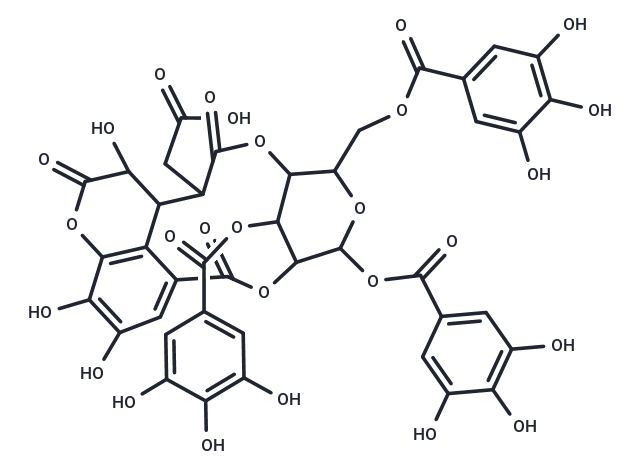Shopping Cart
- Remove All
 Your shopping cart is currently empty
Your shopping cart is currently empty
Chebulinic acid is a potent inhibitor of M. tuberculosis DNA gyrase. It also can inhibit SMAD-3 phosphorylation and H+ K+-ATPase activity.

| Pack Size | Price | Availability | Quantity |
|---|---|---|---|
| 1 mg | $67 | In Stock | |
| 5 mg | $157 | In Stock | |
| 10 mg | $230 | In Stock | |
| 25 mg | $490 | In Stock | |
| 50 mg | $728 | In Stock | |
| 100 mg | $987 | In Stock | |
| 500 mg | $1,980 | In Stock | |
| 1 mL x 10 mM (in DMSO) | $280 | In Stock |
| Description | Chebulinic acid is a potent inhibitor of M. tuberculosis DNA gyrase. It also can inhibit SMAD-3 phosphorylation and H+ K+-ATPase activity. |
| Targets&IC50 | H+, K+-ATPase:IC50 : 65.01 μg/ml |
| In vitro | Chebulinic acid obviously inhibited HQ/Cu(II)- and H(2)O(2)/Cu(II)-mediated pBR322 DNA strand breaks. When MRC-5 cells were treated with HQ/Cu(II), the presence of Chebulinic acid inhibited HQ/Cu(II)-mediated double-strand breaks of genomic DNA [1]. |
| In vivo | Chebulinic acid had no effect on KCl-induced aortic contraction, but irreversibly inhibited the contractile responses to phenylephrine in an apparently non-competitive manner. Chebulinic acid also inhibited contractile responses of rat aorta to 5-hydroxytryptamine and angiotensin II. 3. Chebulinic acid inhibited the binding of [3H]-prazosin to dog aortic microsomal membranes in a concentration-dependent manner with an IC50 value of 0.34 mmol/L [2]. |
| Molecular Weight | 956.68 |
| Formula | C41H32O27 |
| Cas No. | 18942-26-2 |
| Smiles | OC1C2C(CC(O)=O)C(=O)OC3C(COC(=O)c4cc(O)c(O)c(O)c4)OC(OC(=O)c4cc(O)c(O)c(O)c4)C(OC(=O)c4cc(O)c(O)c(OC1=O)c24)C3OC(=O)c1cc(O)c(O)c(O)c1 |
| Relative Density. | 2.04g/cm3 |
| Storage | keep away from direct sunlight,keep away from moisture | Powder: -20°C for 3 years | In solvent: -80°C for 1 year | Shipping with blue ice/Shipping at ambient temperature. | |||||||||||||||||||||||||
| Solubility Information | DMSO: 27.5 mg/mL (28.75 mM), Sonication is recommended. | |||||||||||||||||||||||||
Solution Preparation Table | ||||||||||||||||||||||||||
DMSO
| ||||||||||||||||||||||||||

Copyright © 2015-2025 TargetMol Chemicals Inc. All Rights Reserved.